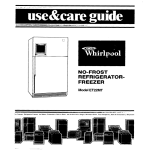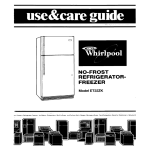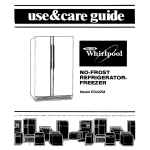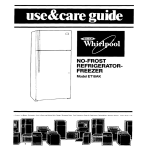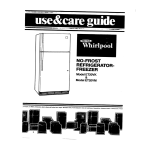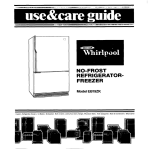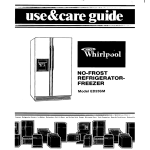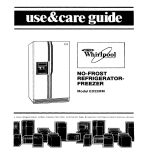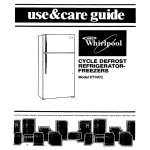Download Whirlpool ETl8EK Specifications
Transcript
C NO-FROST REFRIGERATORFREEZER Model ETl8EK !ers, Freezers, Retrigerator-Freezers. Ice Makers. Dishwashers, Built-In Ovens and Surface Units. Ranges, Microwave Ovens, bash Compactors, Room Air Conditioners. Dehumidlf Please read this Use and Care Guide before you do anything else... This booklet tells you how to start your retrigerator. clean It, move shelves and adjust controls. It even tells you what new sounds to expect tram your refrigerator. Treat your new rehigerator with care. Use it only to do what home refrigerators are designed to do. Parts and features ===i= iIyUJ ; ’ utlllty Compartment / Butter /Compartment Copy your Model and Serial Numbers here... When you need service a call with CYquestion. have this information ready: 1. Comploto Model and Serial Numbers plate located as shown). Model Number (from the Serial Number 2. Purchase date from sales slip Purchase Dote Copy this information in these spaces. Keep this book, your wananty and sales slip together in a handy place. Service Company and Telephone Number Contents SAFETYFIRST BEFOREYOU PLUG IT IN. Page 3 ::::: :: Reversing the Door Swing Ice Cube Trays Optional Automatic Ice Maker Sounds You May Hear, Energy Saving Tips 3 4 4 4 Install Properly Level Refrigerator-Freezer Remove Sales Labels Clean It Plug It In :: 4 CLEANING YOUR REFRIGERATOR 4 USING YOUR REFRIGERATOR. Setting the Controls Changing the Control Settings Power Saving Control Changing the Light Bulb Moving the Meat Pan Adjusting the Refrigerator Shelves Removing Crispers and Crisper Cover Removing and Adjusting the Freezer Shelf Cleaning Chart 5 FOOD STORAGE GUIDE. 5 5 5 Storing Fresh Food Freezing and Storing Frozen Foods 6 6 VACATION AND MOVING CARE IF YOU NEED SERVICE OR ASSISTANCE. 6 6 1. Before Calling For Assistance 2. If You Need Assistance 3. If You Need Service 4. If You Have a Problem 7 01985 Whirlpool Page 7 7 7 8 8 8 9 10 10 11 14 15 15 15 15 15 Corporation Before you plug it in IMPORTANT Before using your refrigerator, you are personally responsible for making sure that it... l is installed and leveled on a floor that will hold the weight, and in an area suitable for its size and use. l is connected only to the right kind of outlet, with the right electrical supply and grounding. (Refer to your “Electrical Requirements and Grounding Instructions:‘) l is used only for jotjs expected of home refrigerators. l l l l l l is not near an oven, radiator or other heat source. is properly maintained. is out of the weather. is used in an area where the room temperature will not fall below 55” F (13” C]. is not wsed by those who may not understand how it should be used is not loaded with food before it has time to get properly cold. Install properly.. . Remove sales labels.. . . Remove the Consumer Buy Guide label, tape and any Inside labels before using the refrigerator. To remove any remalnlng glue: I, Rub briskly with thumb to make a ball then remove. OR 2. Soak area with dishwashing detergent solutron (1 teaspoon detergent in 1 quart warm water] before removing glue as described in step 1. DO NOT USE rubbing alcohol or flammable or toxic solvents, such as acetone, gasoline, carbon tetrachlorlde, etc. These can damage the materlal. NOTE: DO NOT REMOVE ANY PERMANENT INSTRUCTION LABELS INSIDE YOUR REFRIGERATOR. Do not remove the Tech Sheet fastened under the refrlgemtor at the front. Clean it.. . Clean your refrigerator before using it. See cleaning instructions on page 0 1 Allow 3 inches (7.5 cm) between overhead cabinets and refrigerator top. 2. Allow at least an inch [2 5 cm] between the refrigerator condenser on the back and the wall 3. Allow % inch (1.25 cm) on each side of the refrigerator for ease of installatron. 4 If the refrigerator is to be against a wall, you might want to leave extra space on the hinge side so the door can be opened wider Plug it in... j-prong grounding type wall receptacle, -m=i*l*lm Level refrigerator-freezer.. . Leveling screw Retrigerator Power Cord RECOMMENDED Use Screwdriver to Adjust Right to Raise; Lefl to Lower 1. To raise front, turn each screw to the right 2. To lower front, turn each screw to the left 3. Check with level. GROUNDING METHOD A 115 Volt, 60 Hz., AC only 15 or 20 ampere fused and properly grounded electrical supply is required. It is recommended that a separate circuit serving only this appliance be provided. Do not use an extension cord. Use a receptacle which cannot be turned off wlth a switch or pull ohaln. See individual electrical requirements and grounding ature package. instruction sheet in your liter- Setting the controls.. . Controls for the refrigerator and freezer are In the refrigerator. When the refrigerator IS plugged In for the first trme. 1. Set the REFRIGERATOR CONTROL to 3. 2 Glve the refrigerator pletely before addlng tlme to cool down comfood. (This may take sev- These settlngs should be about rfght for normal household refrigerator usage. The controls will be set about right when milk or IS as cold as you like and when ice cream Set the FREEZER CONTROL to B. Changing the control settings.. . If you need to adjust temperatures in refrigerator OTfreezer, use the settings listed in the chart below. l l l CONDITION - : -%-- REASONS: -‘.I.a.-.9N .F--..,.-----..~_I~..-ij.~~ Adjust the Refrigerator Control first. Wait at least 24 hours between adjustments. Then adiust the Freezer Control, if needed. w.-. .--m-, RECOMMENDED SETTINsL.-, CONTROL If Refrigerator Section IS TOO WARM ,~-u-~~ If Freezer Section is TOOWARM Door opened often Refrigerator Large amount of food added Freezer too . warm -“.s-.J z-s i*. I.3-._-Room ..,----“a temperature ~.,..,.. ., ._ . .X.l <.,,m-*1.-4Lb Door opened often Refrigerator Large amount of food added Freezer ’ Very cold rcom temperature QUESTIONS? [can’t cycle _l_l_-dmm-. often enough) )/,v-,-mj__ - e*l.a-B”e-ll ._,,._. . ^-.I, your - _ -.-,-..‘ _.._.- *, .-s-L.-v . ..C.UII If Refrigerator Controls not set correctly Refrigerator COOL-LINED Section is for vmr conditions Freezer I--~ service TOO -“LI---COLD L_I_-,)I_I-.*_._,__Y_. _,.__l...___*_--.,_ “i, ~. ,, --...*~.>nla assistance If ICE isn’t Heavy Ice usage Refrigerator telephone MADE FAST ENOUGH Very cold room temperature Freezer number ,3 [can’t cycle often --,enough) (page 151. ---.“..*-1--Rb.*“” .Y.&T*wLIf BOTH SECTIONS Door ooened often Refriaerator Large amount of food added Freezer Very warm cf very cold room temperatures ---^e,d---il_.Ae.li-...S,,,.~ .i_.aey_I %I c” 3 A 2 B 3 A 4 B Power Saving Control.. . The Power Savlng Control on the Control Console operates electric heaters around the door openings. These heaters help keep moisture from forming on the outside of the refrigerator. I. Use the “CONSUMES LESS ENERGY” setting when humidity is low. 2. Use the “REDUCES EXTERIOR MOISTURE” setting only if moisture forms on the outside of the refrigerator. 5 Changing the light bulb... WARNING: Before removing the light bulb, either unplug the refrigerator or disconnect the electricity leading to the refrigerator at the main power supply. Shock and injury can occur if electricity remains connected. 1 Reach behind control console to find bulb 2. Remove bulb. 3. Replace with a 40-watt appliance bulb Moving the meat pan.. . The meat pan can be taken out and moved the same way as the shelves. Remove the meat pan first. Removlng: 1. 2. 3. 4. 5. 6. Slide the meat pan out to stop. Lift the front of meat pan. Slide pan the rest of the way out. Tilt cover up at front. Lift up at back. Pull straight out. Replacing: I. Guide the rear hooks into the slots in the shelf supports. 2. Tilt up front of cover until rear hooks drop Into slots Lower front of cover to level position. 3. Replace meat pan In reverse order. Adjusting the refrigerator Shelves can be adjusted your refriaerator. shelves... to match the way you use To remove shelves: 1. Tilt UD at front. 2. Lift up at back. 3. Pull shelf straight out To replace: 1. Guide the rear hooks into the slots In the shelf supports. 2. Tilt up front of shelf until hooks drop into slot. Lower front of shelf to level position. Removing crispers and crisper cover.. . Removing the Crispers: Lift the Front, Then the Back. I. Slide crisper straight out to stop, lift front, then slide the rest of the way out. 2 Replace in the reverse order. Removing Cover: I. Lifi front and remove the cover support 2. Lift out cover by pulling up and out. Replacing Cover: I. Fit back of cover into notch supports on walls of refrigerator, then lower front into place. 2. Replace cover support with the long tab towards the front. Note: If support needs adjustment, turn base right to lower, or left to raise. 6 Pull out to stop. :ifl the front and Pull Again. Removing and adjusting the freezer shelf... To remove shelf: 1. Lift front slightly. 2. Lift back off supports. 3. Replace in reverse order To adjust shelf: 1. Remove shelf. 2. Remove supports by sliding upwards. 3. Replace supports on desired level. 4. Replace shelf. Reversing the door swing.. . You can change the hinges on your refrigerator so the doors open the other way. Refer to the instruction sheet included with your refrigerator. Ice cube trays.. . If cubes are not used, they may shrink. The moving cold arr starts a slow evaporation. The longer cubes are stored, the smaller they get Optional automatic ice maker.. . If you have the automatic ice maker accessory or plan to add one later (Part No. ECKMF-83), there are a few things you will want to know: l The ON/OFF lever is a wire signal arm. Down., .for making ice automatically; Up...toshut off the ice maker. l Shake the bin occasionally to keep cubes separated, and to obtain increased storaae capacitv. 1. Hold tray at both ends. l l l l - , l l - Lower Signal Arm to Start It. \ ’ l Raise Signal Arm to Stop Ice Maker. l It is normal for ice crescents to be attached by a corner. They will break apart easily. You WIII hear water running when ice maker is working. You’ll hear ice fall into the bin. Don’t let these sounds bother you. The ice maker will not operate until the freezer is cold enough to make ice. This can take overnight. Because of new plumbing connections, the first ice may be discolored 01 off-flavored. Discard the first few batches of ice. If ice is not being made fast enough and mo(e ice is needed, turn the Refrigerator Control toward a higher number. Wait a day and, if necessary, turn the Freezer Control toward A. If you remove the ice bin, raise the signal arm to shut off the ice maker, When you return the bin, push it all the wav in and lower the arm to the ON position. If cubes are stored too long. they may develop an off-flavor., like stale water. Throw them away. They will be replaced. Cubes in the ice bin can also become smaller by evaporation. The ice maker water supply should not be soffened water. The chemicals could damage the ice maker molds. Sounds you may hear... --. Poulble Slight Hum, Soft Hiss: l l Probable Causes: You may hear the refrigerator’s fan motor and moving air. The defrost timer-makes a definite click when the refrigerator stops running. It also makes a sound when the refrigerator starts. ‘.~.-V.I.~~~U”._I--U,*--XC- --___I_ Water Sounds: When the refrigerator stops running, You may hear gurgling in the tubing for a few minutes after it stops. You may also hear defrost water running into the defrost water pan. Cllcklng Sounds: l l * WUI Sounds: Your new refrigerator may make sounds that Your old one didn’t. Because the sounds are new to you. you might be concerned about them. Don’t be. Most of the new sounds are normal. Hard surfaces like the floor. walls and cabinets can make the sounds seem louder. The following chart describes the kinds of sounds that might be new to you. and what may be making them. --..s.n. Ice or Snapping Mak~r~n~~‘“-‘-.‘-l”- -trickling water -thud (clatter of ice) ,--l Runnlng Sounds: PC.-_-- 1~---~.*--I-- If Your refrigerator has an ice maker, You may hear buzzrng [from the water Valve), trickling water and the clatter of Ice dumped Into the bin ..-ll-al_” >.w*. ....... - _,,-._-. -----. Your refrigerator has a high-efficiency compressor and motor. It will run longer than older designs. It may even seem to run most of the time. -.ay,,.._wa.,.I*a” j- Energy saving tips... You can help your refrigerator use less electricity l Check door gaskets for a tight seal. Level the cabinet to be sure of a good seal. l Clean the condenser coil regularly l Open the door as few times as possible. Think about what You need before you open the door. Get everything out at one time Keep foods organrzed so You won’t have to search for what you want Close door as soon as food is removed o Go ahead and fill up the refrigerator, but don’t overcrowd it so air movement is blocked l l l It is a waste of electricity to set the refrigerator and freezer to temperatures colder than they need to be. If Ice cream is firm In the freezer and drinks are as cold as Your family likes them, that’s cold enough Keep the Power Savrng Control on CONSUMES LESS ENERGY unless moisture forms on refrigerator exterior Make sure Your refrigerator is not next to a heat source such as a range, water heater, furnace, radiator, or In direct sunlight. Cleaning your refrigerator Both the refrigerator and freezer sectrons defrost automatically. But both should be cleaned about once a month to help prevent odors from burlding up. Of course, spills should be wiped up right away. To clean your refrigerator, turn the Refrigerator Control to OFF, unplug it, take out all removable parts, and clean It according to the following drrectrons. , Cleaning chart... L v-1111 s.___I- Part What to use How to clean Removable parts [shelves, crrsper, meat pan etc.) Sponge or cloth; mild detergent and warm water l Sponge, cloth or paper towel; mild detergent; appliance wax [or good auto paste wax]. - Outside Wash removable parts with warm water and a mild detergent. Rinse and dry l Wash with warm water and a mild detergent. Do not use abrasive or harsh l cleansers. Rinse and dry Wax painted metal surfaces at least twice a year with appliance wax or a good auto paste wax. Apply wax with a clean, soft cloth. Do not use wax l l on plastic parts. Waxing -~painted Inside walls Freezer should be ailowed to warm up so cloth won’t stick.) metal surtaces provides rust protection. Soonqe, soft cloth or pap& towel, bakrng soda, warm water, mild detergent l l Door liners ond gaskets Sponge, soft cloth or paper towel; mrld detergent, warm water l l Wash with warm water and - mild detergent or -baking soda (2 tablespoons [26 g] to 1 quart [ 95 I] warm water Rinse and dry ur_-Pm. Wash with mild detergent and warm water, Rinse and dry DO NOT USE Cleaning waxes, concentrated detergents, bleaches or cleansers containing petroleum on plasttc paIts. Dark plastics (covers and panels) Mild detergent and warm water; soft, clean sponge and soft, clean cloth s-.-u SLa.-*.*-- l l W&h with a s% grit-free cloth or sponge. Rinse and dry with a damp grit-free cloth or chamois. US.~Y-,-rs...m-/- DO NOT USE paper towels, window sprays,scouring cleansers, or flammable or toxic solvents like acetone, gasoline, carbon tetmchioride, etc. These can scratch or damage the material. B-P---r-.ss .Defrost pan [behind refrigerator on top of the motor] Sponge or cloth; mild detergent and warm water l l Roll refrigerator out away from wall. Wash defrost pan with warm water and mild detergent. Do not remove detrost pan to clean. l Condenser COIIS z-mUse vacuum cleaner with brush attachment. l l l Floor under refrigerator Usual floor cleaners. l l l l Rinse and dry Roll refrigerator back into place. Clean dust and lint from condenser coils behind the refrigerator at least once every other month. Leave an inch (2.54 cm] between wall and condenser coils on back of the refrigerator Roll refrigerator out away from wall. Wash floor. Roll refrigerator back into place. Check to see if the refrigerator is level. -- *,-a Food storage guide Cured or Smoked Meat and Cold Cuts. Ham. bacon, sausage, cold cuts, etc., keep best in orlginal wrapplngs. Once opened, tightly re-wrap In plastic wrap or aluminum foil. Canned Ham. Store In refrigerator unless the label says It’s okay to store on the shelf Do not freeze. Fresh Pouitry...Wrap in plastic wrap. The plastic wrap on poultry, as purchased, may be used for storage I There IS a right way to package and store refrigerated or frozen foods. To keep foods fresher. longer, take the time to study these recommended steps. Leaty Vegetables Remove store wrapping and trim or tear off bruised and discolored areas. Wash In cold water and drain Place In plastic bag or plastic container and store in crisper Cold, moist air helps keep leafy vegetables fresh and crisp Vegetables with Skins (carrots, peppers).. Store In crisper, plastic bags or plastic container Fruits Wash, let dry and store in refrigerator In plastic bags cx crisper. Do not wash or hull berries until they are ready to use Sort and keep berries In their store container in a crisper, or store in a loosely closed paper bag on a refrigerator shelf Meat* you Meat IS perishable and expensive won’t want to waste an ounce of it through careless handling. The following list and chart give you packaging hints and time limits State meat in the meat pan. Fresh, Prepackaged Meat. State fresh meat In the store wrapping. Vacuum packaged meat can be frozen for as long as one month if the seal IS not broken If you want to keep It frozen longer, you should wrap it with special freezer wrapping material. Fresh Meat, Not Prepackaged. Remove the market wrapping paperand re-wrap in aluminum foil for storing it unfrozen. Cooked Meat. Wrap or cover cooked meat with plastic wrap or aluminum foil. Store immediately IO STORAGE CHARTFORFRESHAM CUREDMEAT* Approximate lime TLPe wwsl Variety Meats . . . . . . . . . . . . . . . . . . . . 1 to2 Chkken . . . . . . . . . . . . . . . . . . . . . . . . . . 1 to2 GroundMel . . . . . . . . . . . . . . . . . . . . . . 1 to2 SteabandRoasts . . . . . . . . . . . . . . . . 3 to5 Cured Meats . . . . . . . . . . . . . . . . . . . . . 7 to10 Bacon . . ..I....................... 5to7 ColdCuts . . . . . . . . . . . . . . . . . . . . . . . . 3 to5 *If meat is to be stored longer than the times given. follow the difectlons for freezing. NOTE: Fresh fish and shellfish should be used the same day as purchased Eggs Store without washing In the orlginal carton or use the Utility Bin that came with your refrigerator. Milk...Wipe milk cartons. For best storage, place milk on interior shelf Beverages ..Wtpe bottles and cans Store on a door shelf or InsIde the refrigerator. Butter...Keep opened butter in covered dish or In the Butter Compartment When storing an extra supply. wrap in freezer packaging and freeze. Cheese .Stofe in the original wrapping until you are ready to use it. Once opened, re-wrap tightly in plastic wrap or aluminum foil. Condlments .Store small jars and bottles (catsup, mustard, jelly, olives) on the door shelves where they are in easy reach. Leftovers Cover leftovers with plastic wrap or aluminum foil to keep food from drying out and transferring food odors. Plastic containers with tight lids are fine, too I FREEZING & STORING FROZEN 3 The freezer section is de&ed for storage of commerclally frozen foods and for freezlng foods at home. Packaging - The secret of successful freezing is in the packaging. The wrap you use must be air, moisture and vapor proof. The way you close and seal the package must not allow air, moisture or vapor in or out. Packaging done in any other way could cause food odor and taste transfer throughout the refrigerator and drying of frozen food. Rigid polyethylene (plastic] containers with tightfitting IIds, straight-sided canning /freezing jars, heavy-duty aluminum foil, plastic-coated paper and non-permeable plastic wraps (such as Saran] are recommended. Note, Heat-sealed boiling bags are easy to use and can be used by themselves of as carton liners. Sealing - When sealing foods in bags squeeze out the air (liquids need headspace to allow for expansion.) Twist the top and turn it back. fasten tie securely around the doubled-over tail. Put the label InsIde transparent bags; use self-adhesive label on outside of opaque ones. Air-tight wrapping calls for “drugstore” wrap. Cut the sheet about one-third longer than the distance around the food. Bring the ends together and fold in (toward the food) at least twice to seal out air. Crease ends close to food, press air from package. Fold tips 6 over twice. Finish package and tape closed. NOTE: With unboned meats, pad sharp edges with extra wrap or use stockinette to protect the wrap from punctures. r DO NOT USE. Bread wrappers l Non-polyethylene plastic containers l Containers without tight llds l Waxed paper l Waxed-coated freezer wrap l Thin, semi-permeable wrap None of these are totally moisture. air or vapor proof The use of these wrappings could l cause tood odor and taste transter and drying of trozen food. Freezlng Fruits - Select ripe, blemish-free fruits. Be sure they taste as good as they look. Wash 2 to 3 quarts [liters) at a time and drain. Fruit that stands in water may lose food value and become, scggy, Sort, peel, trim, pit and slice as needed. Pack in rigid wide-mouthed containers or other recommended material. Leave head space to allow liquids to expand during freezing. Freezing Vegetables - Freeze only fresh highquality vegetables plcked when barely mature For best results, freeze no more than 2 to 3 hours after picking. Wash in cold water, sort and cut into appropriate sizes. Blanch or scald. Pack in recommended container and freeze. Do not freeze lettuce, celery, carrot sticks, potatoes or fresh tomatoes. All will become limp or mushy. Tomatoes will collapse when thawed. Freezing Cooked Food - Prepare cooked foods as you would for the table, shorten cooking timel0to15m~nutestoallowforadd~t~onal cooktng during reheating. Omit seasonings and part of the liquid. Plan to add them at reheating time Potatoes should also be added to soup and stew at heating time. Add crumb and cheese topplngs at heattng time Cool as rapidly as possible and freeze at once. Liquid of semi-llquld dishes may be frozen In recommended containers with head~spoce Casseroles and other more solid foods may be frozen in the baking container If you don’t want to leave your casserole dish In the freezer, line It with foil. Bake, cool, freeze, lift out the foil package, bag it and return to freezer. Freezlng Meats-The meat you thaw can only be as good as the meat you freeze. “Drugstore” wrap in meal-size packages. Flat cuts or patties should be wrapped indlvldually OT in layers separated by a double thickness of freezer wrap. Make sure store wrappings are moisture and vapor proof. If not, re-wrap meats with one of the wraps recommended under “Packaging”. Freezlng Baked Goods -Wrap baked breads In recommended material. Thaw in wrapplng. Unbaked yeast breads can be frozen after the first rising. Punch down. wrap and freeze Bake cookies as usual Cool and freeze on trays, then pack in recommended freezer bags or cartons. Unbaked cookies may be dropped, molded or rolled and frozen on cookie trays. Store in bag or carton; bake wlthout thawing. Refrigerator-type cookies can be wrapped and frozen In roll form. Thaw only enough to slice when ready to bake. Fruit pies are best frozen unbaked. Bake without thawing. Bake pecan and similar pies before freezlng...rich fillings do not freeze solid. Cut steam vents in top crusts when ready to bake. 12 IMPORTANT: Do not expect your freezer to quick-freeze any large quantlty of tood. Put no more untrozen tood tnto the freezer than will treeze wlthln 24 hours. (No more than 2 to 3 pounds of fresh meat or 3 to 4 pounds ot vegetables per cubic toot of freezer space.) leave enough space for air to circulate around packages. Be careful to leave enough room at the front so the door can close tightly. FOODSTORAGECHART Storage times* will vary according to the quality of the food, the type of packaging or wrap used (moisture and vapor-proof). and the storage temperature which should be 0” F (-17.8C). Btorago tlme Food FRUITS Fruit Juice concentrate . . . . . 12 months Commerclolly trozen trult . . 12 months Citrus hult and )ulces . . . . 4 to 6 months Others . . . . . . . . . . , . . . . . . 8 to12 months VEGETABLES Commercially trozen . . . . . . . 8 months Home trozen . . . . . . . . . . . 8 to 12 months MEAT Bacon . . . . . . . . . . . . , . . . 4 weeks or less Corned beet . . . . . . . . . . . . . . . . . 2 weeks Cured ham . . . . . . . . . . . . . 1 to 2 months (Saltlng meot shortens treezer Ilte) Frankturters . . . . . . . . . . . . . . . . . . 1 month Ground beet, lamb, veal 2 to 3 months Roasts: Beet . . . . . . . . . . . . . . . . . 6 to 12 months Lomb and veal . . . . . . . 6 to 9 months Pork . . . . . . . . . . . . . . . . . . . 4 to8 months Sausage, tresh . . . . . . . . . . 1 to 2 months Steaks and chops: Beet . . . . . . . . . . . . . . . . . 8 to 12 months lamb, veal, pork . . . . . . 3 to4 months FISH Cod, Rounder, haddock Sole....................... 6months Blue tlsh, salmon . . . . . . . . 2 to 3 months Mackerel, perch . . . . . . . . 2 to 3 months Breaded fish (purchased) . . . 3 months Clams. oysters, cooked tlsh, crab, scallopa . . . . 3 to4 months Alaskan klng crab , . . . . . . . . 10 months Shrimp, uncooked . . . . . . . . . 12 months POULTRY Whole chlcken or turkey,. . . 12 months Duck . . . . . . . . . . . . . . . . . . . . . . . . 6 months Giblets . . . . . . . . . . . . . . . . . . 2 to 3 months Cooked poultry w/gravy . . . 6 months Slices (no gravy) . . . . . . . . . . . . . 1 month hod Bteroge time MAIN MSHES Stews; meat, pouRtry and ttsh casserole . . . . 2 to 3 months TV dinners.. , . . . . . . . . . . . . 3 to6 months DAIRY PRODUCYS Butter :. . . , . . . . . . . . . . . . . . 6 to 9 months Margartne . . , . . . . . . . . . . . 2 to 9 months Cheese: Camembert. brkk. Moz~arelk,tarmer’s . . . . 3 months Creamed cottage . . DO NOT FREEZE Cheddar, Edam; Bouda, Swlss,etc . . . . . , . . . . . ..6to8weeks Freezlng can change texture ot cheese. Ice cream, ice milk sherbet . . . . . . . . . . . . . . . . . . . . 4weeks EGGS Whole (mlxed) . . . . . . . . . 9 to 12 months Whites . . . . , . . . . . . . . . . . , 9 to12 months Yolks . . . . . . , . . . . . . . . . . . . 9 to12 months (Add sugar or salt to yolks or whole mixed Km1 BAKED GOODS Yeast breads and rolls , . . . . . 3 months Baked Brown ‘N Serve rolls . . . . . . . . . . . . . . . . . . . . . . . 3 months Unbaked breads.. . . . . . . . . . . . 1 month Quick breads . . . . . . . . . . . 2 to 3 months Cakes, untrosted . . . . . . . . 2 to 4 months Cakes, trosted . . . . . . . . . 8 to 12 months Fruit cakes . . . . . . . . . . . . . . . . . 12 months Cookie dough . . . . , . . . , . . . . . 3 months Baked cookies . . . . . . . . . 8 to12 months Bakedples... .,.. B. . . . . . lto2months Pie Uough only . . . . , . . . . . 4 to 6 months ‘Based on U.S.D.A. and Michlgon wggesfed storage times. It electrlclty Cocperati~e Evtensicn Service goes off Call the power company Ask how long power WIII be off 1. If service IS to be Interrupted 24 hours or less. keep both doors closed This WIII help frozen foods to stay frozen 2. If service IS to be Interrupted longer than 24 hours (a] Remove all frozen food and store In a frozen food locker Or.. (b) Place 2 Ibs (0.9 kg) of dry ice In freezer for every cu. ft of freezer space This will keep frozen foods for 2 to 4 days. Wear gloves to protect your hands from dry ice burns, (c) If neither food locker storage nor dry ice is avallable, use or can perishable food at once. 3. A full freezer will stay cold longer than a partly filled one. A freezer full of meat will stay cold longer than a freezer full of baked goods. If food contains ice crystals, it may be safely refrozen, although the quality and flavor may be affected. Use refrozen foods quickly. If the condition of the focd is poor or you have any suspicrons, It IS wtse to dispose of it. 13 Vacation Short vacations. . . Moving. . . No need to shut off the refrigerator If you will be away for less than four weeks, Use up perishables, freeze other items. If your refrigerator is equipped with an automatic ice maker, 1) turn it off; 2) shut off the water supply to the ice maker; 3) empty the ice bin. If your refrigerator is equipped with an automatic ice maker, shut off the ice maker water supply a day ahead of time. Disconnect the water line. After the last supply of ice drops, lift the signal arm to turn off the ice maker. Remove all food. Pack frozen foods in dry ice. Unplug the refrigerator and clean it thoroughly. Remove everything that comes out. Wrap all parts well and tape them together so they don’t shift and rattle. Screw in the levelling rollers; tape the doors shut; tape the electric cord to the cabinet. When you get to your new home, put everything back. and refer to page 4. Don’t forget to reconnect the water supply line if you have an icemaker. Long vacations. . . Remove all the food ii you are going for a month or more. If your refrigerator IS equipped with an automatic ice maker, turn off the water supply to the ice maker at least a day ahead. When the last load of ice drops, turn off the ice maker. Unplug the refrigerator and clean it...rinse well ar,d dry. Tape rubber or wood blocks to both doors .-keeping them open far enough for air to get in. This will keep odor and mold from building up. WARNING: Tape blocks out reach...do not allow the refrigerator when blocked open. They InJured or trapped. To restart refrigerator. 14 of a child’s children near the doors are may become see “Using Your Refrigerator.” QUESTIONS? If need service or assistance, we suggest you follow these four steps: you 1. Before calling for assistance... 3. If you need service*... Performance problems often result from little things you con find and fix yourself without tools of any kind. Whirlpool has a notionwide network of franchised TECH-CARE@ Service Companies. TECH-CARE service technicians ore trained to fulfill the product wananty and provide after-warranty service, anywhere in the United States. To locate .TECH-CARE service in your area, call our COOL-LINE service assistance telephone number (see Step 2) a look in your telephone directcxy Yellow Pages under: If your refrigerator will not operate: Is the electric cord plugged in? Is a fuse blown or a circuit breaker tripped? Is the Refrigerator Control turned ON? l l l If there Is a rattltng unfamlllar sounds: or Jlngllng nolse, or other Is something on top or behind the refrigerator making noise when the refrigerator is running? New features on your new refrigerator make new sounds. You may be hearing oir flowing from the fans, timer clicks for the defrosting cycle, defrost water draining into the defrost pan. l l If your Ice maker will not operate: OR Has the freezer hod enough time to get cold? With a new refrigerator, this might take overnight. Is the signal arm ON,, in the down position? Is the water valve turned on? Is water getting to the ice maker? l l l WHIRLPOOL APPLIANCES FRANCHISED TECH-CARE SERVICE WHIRLPOOL APPLIANCES FRANCHISED TECH-CARE SERVICE SERVIC’E CO,MPA.CIES XYZ SERVICE CO 999.9999 123 Maple SERVICE COMPANIES XYZ SERVICE CO 999-9999 123 Maple OR WASHING MACHINES. 6 IRONERS-SERVICING If there Is water In the defrost pan: In hot, muggy weather. this is normal. The pan con even be half full. Make sure the refrigerator is level so the pan doesn’t overflow. l breakers. Make SERVICE XYZ SERVICE CO 123 t&DIE See instructions for changing 6. Use appliance bulbs only. l l 999-9999 4. If you have a problem*. . . light bulbs on page If the motor seems to run too much: l COMPANIES sure it’s If a bulb Is burned out: l DRVERS WHIRLPOOL APPLIANCES FRANCHISED TECH-CARE SERVICE If the light doesn’t work: a Check fuses and circuit plugged in. ELECTRICAL APPLIANCESMAJOR - REPAIRING 6 PARTS APPLIANCES - HOUSEHOLD. MAJOR-SERVICE 6 REPAIR Are the condenser coils free of dust and lint? On hot days, OT if the room is worm, the motor naturally runs longer. If the door has been opened a lot, or if Q large amount of food has been put in, the motor will run longer to cool down the interior Remember: Motor running time depends on different things: number of doa openings. amount of food stored, temperature of the room. setting of the controls. And. your new refrigerator may be larger than your old one so it has mcfe space to be cooled. It also has a regular freezer instead of a frozen focd compartment. All this means better refrigeration and may require more running time than your old one. 2. lf you need assistance*..~ Call Whlrlpool COOL-LINE@ servlte asslstanoe telephone number. Dial free from: Contlnental U.S. . , . . . . . . . . . . (500) 2534301 Mlthlgan .,. . , . . . . . . . . . . . . . . . (500) 632-2243 Alaska 81Hawall . . . . . . . . . . . (500) 253-l 121 and talk with one of our trained Consultants. The Consultant can instruct you in how to obtain satisfactory operation from your appliance or, if service is necessary, recommend a qualified service company in your area. Call our COOL-LINE service assistance telephone number [see Step 2) and talk with one of our Consultants, or if you prefer, write to: Mr: Stephen E. Upton, Sr. Vice President Whirlpool Corporation Administrative Center 2000 US-33 North Benton Harbor, Ml 49022 ‘If you must call or write, please provide: model number. serial number, date of purchase. and a complete description of the problem. This information is needed in order to better respond to your request for assistance. 0 FSP a3 FSP IS a regrstered trademark of Whirlpool Corporation for quality parts Look foe this svmbol of qualltv whenever you need a replacement Part for your Whirlpool appliance FSP replacement parts will fit right and work right. because they are made to the same exacting specifications used to build every new Whirlpool appliance Making Part No. 1105797 01985 Whirlpool Corporation your world a little easier. Prlnted in U.S.A. ce Makers, Dishwashers, Built-In Ovens and Surlace Units, Ranges. Mrcrowave Ovens. Trash Compactors, Room Air Conditioners, Oehumrdifiers. Automatic Washers, Clothes OrI
















